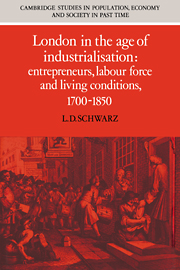Book contents
- Frontmatter
- Contents
- List of figures
- List of tables
- Acknowledgements
- List of abbreviations
- Introduction
- Part I Wealth and occupations in London
- Part II Fluctuations and mortality in the metropolis
- Part III The standard of living and the London trades
- Conclusion: downstream from industrialisation
- Appendices
- Bibliography
- Index
- Cambridge Studies in Population, Economy and Society in Past Time
Part III - The standard of living and the London trades
Published online by Cambridge University Press: 11 September 2009
- Frontmatter
- Contents
- List of figures
- List of tables
- Acknowledgements
- List of abbreviations
- Introduction
- Part I Wealth and occupations in London
- Part II Fluctuations and mortality in the metropolis
- Part III The standard of living and the London trades
- Conclusion: downstream from industrialisation
- Appendices
- Bibliography
- Index
- Cambridge Studies in Population, Economy and Society in Past Time
Summary
One of the most common methods used by historians when discussing living standards is to produce a series of wage rates and a series of prices, divide the two and emerge with a real wage rate series. This method makes no pretence of examining the quality of life, problems of urbanisation, sanitation, health and so forth, but it is of some help for those examining material living standards. There are obvious drawbacks to this approach, such as whether the trades for which data happens to have survived were representative, as well as the inevitable drawback that the data by its very nature makes no allowance for unemployment, and tends to refer to adult men. Prices are also problematic: most of the surviving information is about wholesale prices. Since we know little about consumption patterns in the past, there are problems of constructing suitable weights for an index.
These are all problems that can be more or less overcome – at least if one is not interested in the short run – and an index, with all its strengths and weaknesses, is duly presented in chapter six. The suggestion is that real wage rates (and to a considerable extent real wages) were comparatively high during the second third of the eighteenth century, falling thereafter, and rising again after the Napoleonic Wars. The decline of the second half of the eighteenth century is a pattern common to southern England, while the nineteenth-century rise appears to be part of a national pattern.
- Type
- Chapter
- Information
- London in the Age of IndustrialisationEntrepreneurs, Labour Force and Living Conditions, 1700–1850, pp. 157 - 160Publisher: Cambridge University PressPrint publication year: 1992



